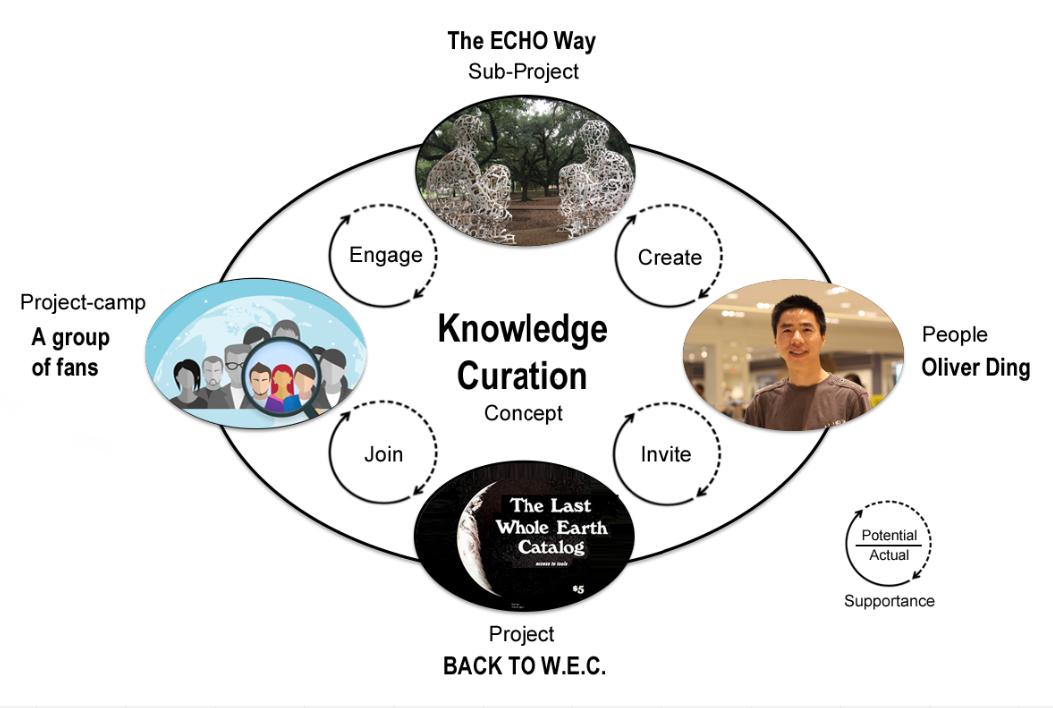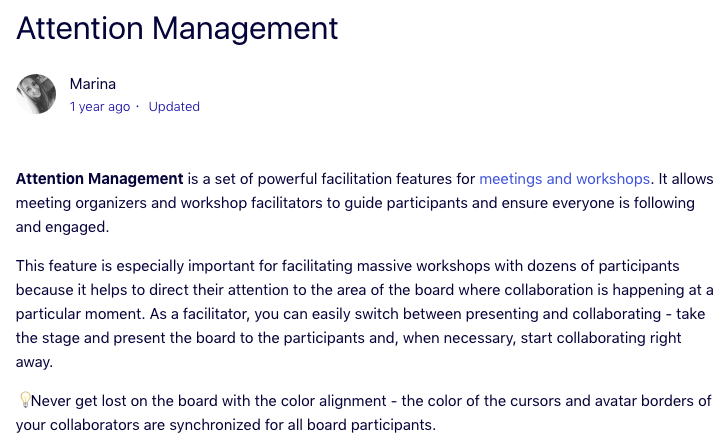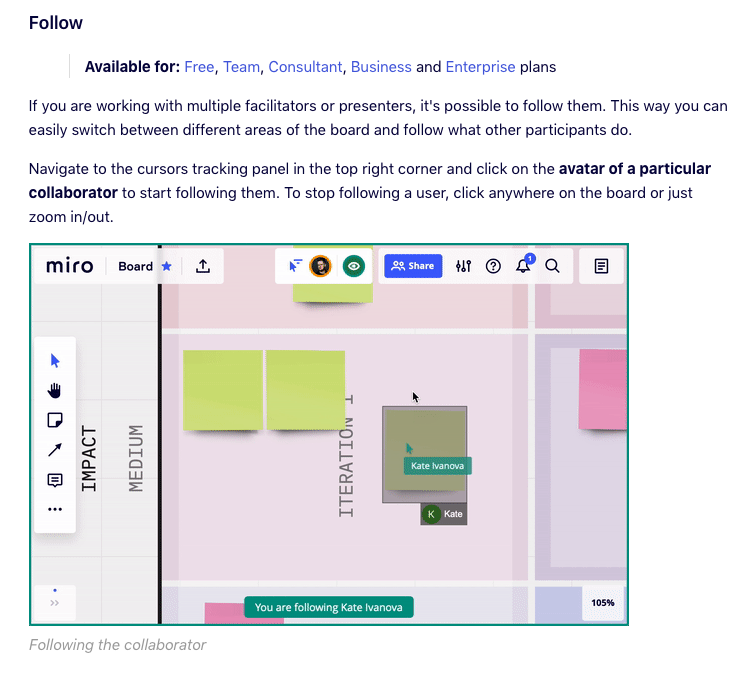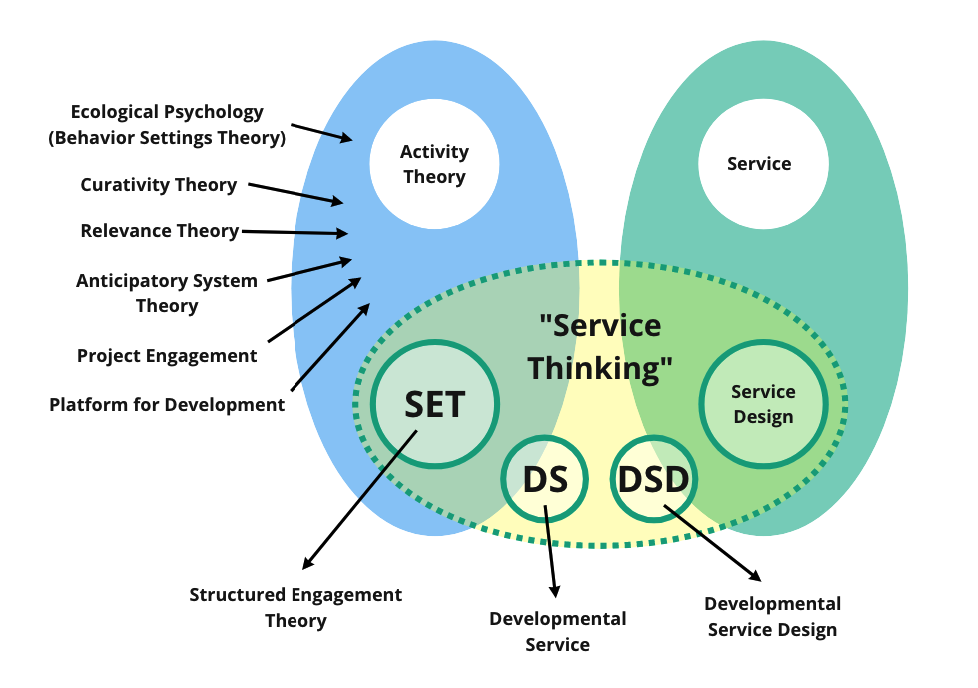Platform-based Service

How do ambitious creators use digital platforms to host their own services?
On Dec 13, 2020, I published the Platform-for-Development (P4D) framework (v1.0). In March 2021, I renamed it “Developmental Project” and worked on v2.0 of Platform-for-Development. An outcome is a supportive approach to adult development with an ecological mindset.
The v2.0 framework adopts Project-oriented Activity Theory and the Ecological Practice approach as theoretical resources. In order to connect theory and practice, I develop several intermediate concepts and frameworks. These ideas are presented in several articles.
On March 31, 2021, I collected these articles and edited a book (draft) titled Platform for Development: The Ecology of Adult Development in the 21st Century.

The book offers a series of frameworks and models for understanding developmental platforms and adult development. One model is called the Supportive Cycle. See the diagram below.

The above diagram represents the model of the Supportive Cycle. The four types of entities are Platform, People, Project, and Platformba. The four movements are labeled as 1, 2, 3, and 4 in the diagram. However, these numbers don’t refer to steps or stages. I consider these interactions are parallel development. The focus of the Platform-for-Development framework is not studying the development of individual entities such as the development of digital platforms, but the relationship between people and the whole Platform(Project) from the perspective of adult development.
The Supportive Movement is defined by the concept of Supportance which refers to the potential supportive possibilities for actions. Each movement is divided into two states: the Potential status and the Actual status. The relationship between two entities is roughly considered as “environment” and “organism” from the ecological perspective. One side (as “environment”) offers Supportances to the other side (as “organism”).
There are several possible situations within a supportive movement. You can find more details about four supportive movements in The Supportive Cycle (v1.0).
Case Study: TED(TEDx)
For example, by considering TED as a Platform and TEDx as a Project, we can build an exemplar of the Supportive Cycle.

The above diagram highlights the structure and dynamics of the TED(TEDx) case.
- Platform: TED
- People: local TEDx event organizer and volunteers
- Project: the TEDx program and local TEDx events
- Platformba: the global TED/TEDx community
We can also identify four primary themes of supportive movements:
- License: TED offers the TEDx open brand license for local social change-makers who want to organize a local TEDx event.
- Curate: A local TEDx event offers action opportunities for curating a TEDx event for local volunteers.
- Engage: A local TEDx event offers participatory opportunities for local speakers and audiences.
- Follow: TED offers free TED talks and TED-related information to local TEDx organizers, volunteers, speakers and audiences through multiple channels.
This case is an ideal case of the Platform-for-Development framework. We have to pay attention to a special issue that the TEDx program is initiated and managed by TED. In other words, there is a strong tie between Project and Platform. However, the original motivation of the Platform-for-Development framework is studying digital social platforms which refer to the weak tie between Project and Platform.
Furthermore, it is possible to escape from the dichotomy of strong ties and weak ties. We may find more types of relationships between Project and Platform. This is an open issue for the Platform-for-Development framework.
Case Study: Youtube (Patreon)
While the Platform-for-Development framework focuses on adult development, the Supportive Cycle is also suitable for discussing platform ecology because it incorporates the pair concept of Platform/Platformba. In other words, the Supportive Cycle can support both the Platform-for-Development framework and Platform Ecology.
Here we need a trick. We can consider Product (or small platforms) within the #SocialPxD framework as Project within the Supportive Cycle model.
Let’s use YouTube (Platform) and Patreon (Project) as an example for further discussion.

YouTube is the largest online video-sharing platform that allows people to publish their videos. Each YouTube user account has a video channel that allows audiences to subscribe in order to receive the newest update from the channel. Patreon is a membership platform that allows artists and creators to launch and maintain their subscription programs for earning a monthly income from their fans by offering rewards and perks.
The above diagram highlights the structure and dynamics of the YouTube(Patreon) case.
- Platform: YouTube
- People: YouTubers
- Project: Patreon
- Platformba: All users of YouTube, such as YouTubers, audiences, fans and sponsors.
We can also identify four primary themes of supportive movements within this case:
- Make: YouTubers make videos and publish these videos on their YouTube channels.
- Curate: YouTubers create accounts on Patreon and design, maintain and update membership programs with their Patreon accounts.
- Sponsor: Fans join membership programs and support YouTubers on Patreon.
- Watch: Audiences and fans watch videos on YouTube.
This case is an ideal case for both the Platform-for-Development framework and Platform Ecology.
According to Wikipedia, “Patreon was co-founded in May 2013 by Sam Yam and musician Jack Conte, who was looking for a way to make a living from his YouTube videos. Together with Sam Yam, he developed a platform that allows ‘patrons’ to pay a set amount of money every time an artist creates a work of art.” Four years later, YouTube launched Twitch-like sponsorships to all YouTubers in September 2017. The YouTube channel memberships feature was announced in June 2018.
For the Platform-for-Development framework, we adopt the Supportive Cycle from the perspective of YouTubers who want to earn enough income to sustainably support their YouTube video-making activities. Though YouTubers successfully build trust relationships with their fans, YouTube didn’t provide sponsorship and membership features for YouTubers before 2017.
In 2013, Patreon’s founders perceived a specific supportance within the platformba of YouTube: fans could support YouTubers by becoming their sponsors. However, YouTubers need a way to turn this supportance into real support. Patreon provided a tool for actualizing this supportance. Thus, we can claim that Patreon was born from the platformba of YouTube.
Let’s summarize the story by using our concepts: a member of the platformba of YouTube initiated a project which helps one group of the platformba actualize one supportance offered by another group of the platformba.
For discussing Platform Ecology, we adopt the Supportive Cycle from the perspective of Patreon which is considered a product or a small platform. The growth of Patreon is a great exemplar of Outside Construction and Inside Construction.
As mentioned above, Platformba could be bigger than its platform. So, activities of a platformba can happen inside and outside of its platform. Now, we see two platforms within the platformba of YouTube. For YouTubers who adopt Patreon, it is natural to add links to their Patreon profile in the bio area of their YouTube channels and the description area of video pages. For Patreon, these behaviors are Outside Construction. For YouTube, these behaviors are Inside Construction.
The above discussion is only for testing the supportive cycle model. For a real case study, we can take multiple cycles to describe a case from several perspectives. The most interesting about platformba is Creativity, Emergency, and Curativity, a deep discussion of this topic is beyond the scope of this article.
Platform-based Service
In April 2021, I started researching Platform-based Services from the perspective of Platform for Development. I focused on the following question:
How do ambitious creators use digital platforms to host their own services?
Milanote
The first project is about Milanote which is a digital whiteboard platform. In April 2021, my friends hosted a two-month program for online discussions about a magazine: The Whole Earth Catalog. They used Milanote, Wechat, and various video meeting platforms for the program.
I joined the program as a researcher and collected various types of data such as all Milanote boards under the program, notifications from Milanote, WeChat group messages, and weekly meeting videos.

Initially, I used the Supportive Cycle model to develop a model for the program. See the above diagram. However, I found it's better to use multiple frameworks for understanding the program. Each framework has its own specific perspective which generates related insights. If we apply multiple frameworks, we can capture more insights.
Miro
The second project is about Miro which is a digital whiteboard platform too. The project is called Once Upon A Whiteboard. Since it is an independent research project, I used the lean study method to manage the project. I worked on matching frameworks and platforms and researching real work cases one by one.
One great insight into matching frameworks and platforms is about Miro's "Attention Management" feature. See the attached screenshots.


In my 2021 book Platform for Development, I introduced a set of new theoretical concepts. One of them is Supportance which refers to potential action possibilities offered by the social environments. Since Supportance is about potential action possibilities, there is a step called "Actualization of Supportance" between potential actions and actual actions. It is also called "Taking Supportance".
I found Miro's "Attention Management" features offer me a great example of "Taking Supportance" for product discovery and design. From the perspective of Supportance, facilitators' or presenters' mouse tracks could guide participants' attention. Miro turns this supportance into a feature.
Lark Suite
In June 2021, one of my friends started an online adult development program. As a new product designer and founder, she hosted a monthly peer-support group on Lark Suite which is an enterprise collaboration platform.
I’d like to call the program SSL which stands for Shaper & Supporter Lab. Anyway, it is just a codename.
The program was designed with three components: 1) Life Purpose Awareness, 2) Personal OKR Practice, 3) Peer Review and Feedback. My friend also adopted the Building In Public approach to sharing her goals, challenges, progress, and discussions with others on social media platforms.
I use the Project Engagement approach to guide my research about the program. The approach uses a method called “Multiple-level Project Engagement”. I reflect on the following levels:
- The “My friend — Members” Engagement
- The “Member — Member” Engagement
- The “I — My friend” Engagement
This method is what I called “Cultural Projection Analysis” of Project-oriented Activity Theory. You can find more details here: Activity U (X): Projecting, Projectivity, and Cultural Projection.
My friend started the journey in Feb 2021. In April 2022, we worked on reflecting on her life transition in the past 12 months. In the process of reflection, I realized that she did two activities during the one-year journey.
- Second-order Activity: She spent several months on Life Discovery.
- First-order Activity: Seh started the Shaper & Supporter Lab program as a Developmental Project.
I also observed that she also worked hard on modeling her project and storytelling about her life discovery.
The program used Lark as the digital platform and design a supportive development digital environment for young professional workers.

I applied the SET framework to model the program. See the above diagram.
- Lark: technological environment
- The Program @ Lark: situational environment
- The Program in general: organizational environment
I also applied Ecological Observation, Participatory Research, Thematic Analysis, and Theory-based Reflection to research the project. I studied the design of the program and its real performance. I collected data about the program, for example, the weekly meeting videos. The research refers to the developmental process of a project. I used the thematic analysis method to discuss several potential tensions of the program.
The research project contributed to both theoretical development and practical development. For me, the project tested a new framework called Anticipatory Activity System (AAS). For her, the project helped her improve the design and the decision of the program.
Service Thinking
In 2021, I used the SET framework to study Digital Whiteboard Platforms. I recently used the SET framework to study an adult developmental program. This change encourages me to think about the connection between Activity Theory and Service Design. See the diagram below.

Finally, I found the notion of “Developmental Service Design” is a great connector.
- SET: Structured Engagement Theory
- DS: Developmental Service
- DSD: Developmental Service Design
- SD: Service Design
Since Developmental Service is a special type of service, Developmental Service Design is part of Service Design too.
According to Marc Stickdorn and Jakob Schneider who are the authors of This Is Service Design Thinking, “Service Design is an interdisciplinary approach that combines different methods and tools from various disciplines. It is a new way of thinking as opposed to a new stand-alone academic discipline. Service design is an evolving approach, this is particularly apparent in the fact that, as yet, there is no common definition or clearly articulated language of service design.”(2011, p.29)
In 2017, they published a new book titled This is Service Design Doing which is a practitioners’ handbook. They point out that “Service Design adopts the mindset and workflow of the Design Process, combining an active, iterative approach with a flexible and relatively light-weight set of tools borrowed from marketing, branding, user experience, and elsewhere. ”(2017, p.13)
The Service Design community shares a set of tools (such as Journey Mapping, Prototyping tools, Business Model Canvas, etc) with other communities such as the Lean Startup community, Design Thinking community, etc.
Developmental Service Design could adopt the mindset and workflow of the Design Process and tools from the Service Design community, it also could expand its toolkits from Developmental Service Study.
This is the amazing engagement between Theory and Practice. Each dialogue always leads to a new creative space.
